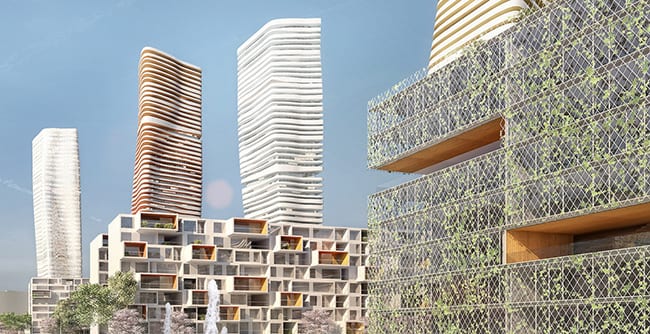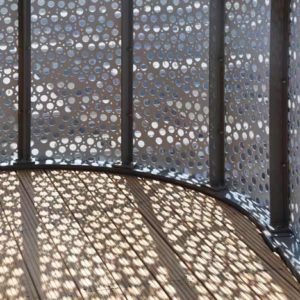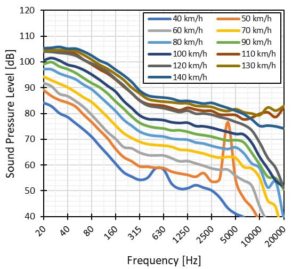When Condos “Sing”: Assessing Wind-Induced Balcony Railing Noise

Acoustic Surprises: Wind-Generated Noise and its Mitigation in Buildings and Structures Explained
The Golden Gate bridge in San Francisco, California attracts approximately 10 million tourists every year. In the spring of 2020, locals and tourists alike started hearing an unexpected and unusual sound seemingly emanating from the bridge; the sound was described alternatively as a loud hum; an eerie song; or as one article in the Guardian put it, a “giant orange wheezing kazoo”. It was loud enough (especially on windy days) that it could be heard several miles away. News of this mysterious “eerie humming sound” and conjectures about its genesis quickly went viral.
After some investigation by local authorities, the origin and direct cause was identified. A short time before the “singing” sounds were first heard and began drawing attention, the hand railings had been replaced on the bridge to make the structure more aerodynamic and able to withstand gusts of up to 100 miles per hour,
The new railing design, which featured a pattern of repeating vertically aligned pickets, produced an acoustic tone at certain wind speeds. Although the engineers responsible for the new railing design had anticipated that it would make some noise under certain wind conditions, they had not anticipated the level of sound that resulted and the subsequent complaints from locals. It seems one person’s “singing” is another’s wheezing kazoo.
Balcony Railing Designs and Wind-induced Noise
These kind of possible sound issues don’t just arise from bridge features. Modern condo towers as well can be prone to the same unwelcome noise out-comes. Mysterious ringing sounds that rattled residents in central Edmonton, Alberta were also suspected to be caused by strong winds acting on balcony railings from a new residential hi-rise. Condo towers can be wrapped in balcony railing panels of countless styles, shapes, and materials. At the height of the top floors of tall towers, wind shear produces wind at several times the speed at ground height, and the wind speed can be extreme.

In general, there are two types of balcony railing panel designs: a solid material (usually glass) or a perforated material (usually aluminum). While it may be possible for a solid glass railing to generate noise, it is not typically a concern we have been called on to assess and/or mitigate. On the other hand, when it comes to perforated aluminum railing designs on condo balconies, there are many possible combinations of wind speeds and angles of attack that can induce unwelcome sound.
The Benefits of Acoustically Assessing Balcony Railing Design Early on in a Project
Given the complexity of the mechanism that produces tonal sound from balcony panels, and given the cost of retrofitting existing panels, it is important to consider how a balcony railing panel will behave in the wind before the panels are installed, during the design phase.
Aeolian excitation (a.k.a. the wind) can cause a structure to vibrate, which under certain conditions and within a certain range of frequencies can lead to unwelcome sound. Thin, flat surfaces, like balcony railing panels are particularly good at converting vibration to sound, much like the diaphragm of a speaker.
There are two dominant mechanisms that can produce wind-generated noise at the perforations: vortex shedding, where the wind passes along the face of the railing over a repeating pattern of holes or slots, and jet noise due to wind flowing through the perforations. A third mechanism relates to the Helmoltz resonator effect, similar to blowing over the top of a bottle, but the lack of a defined volume behind the balcony panels renders this mechanism inapplicable.
The likelihood for a balcony railing panel to generate noise is dependent on many factors, including but not limited to the wind speed, the angle of attack of the wind, and the size and shape of the perforations. Because the flow of the wind over a small area is extremely difficult to predict or to model accurately, the interaction between the balcony railing panels and the wind is also difficult to predict. Therefore, we have found the most comprehensive way to evaluate how a balcony railing panel will behave is to test it in a wind tunnel.

Wind-Tunnel Testing of Balcony Railing Design Mock-ups for Noise
HGC has been called on by several developers during the design phase of a project to test full-sized balcony railing mock-ups inside of a wind tunnel. The wind tunnel environment allows us to measure the behavior of a balcony panel design at any wind speed and angle of attack in a controlled and predictable environment, and to evaluate several perforation designs for their potential ability to generate sound under varying wind conditions. Wind speeds of up to hurricane strength can be tested with the proper setup.

During wind tunnel testing our acoustical consultants measure sound, vibration, and wind speed data in high-resolution in a variety of locations on and near the mock-up, using state-of-the-art acoustical instrumentation. The complex interactions between the balcony railing panel and the wind is analyzed to ensure that no wind-induced tonal noise is present. Should tonal noise be detected, we can then assess the cause and recommend various options to the project development team, including changes to the panel design or retrofit options for an existing panel. In many cases, these options can be tested and verified within hours.

